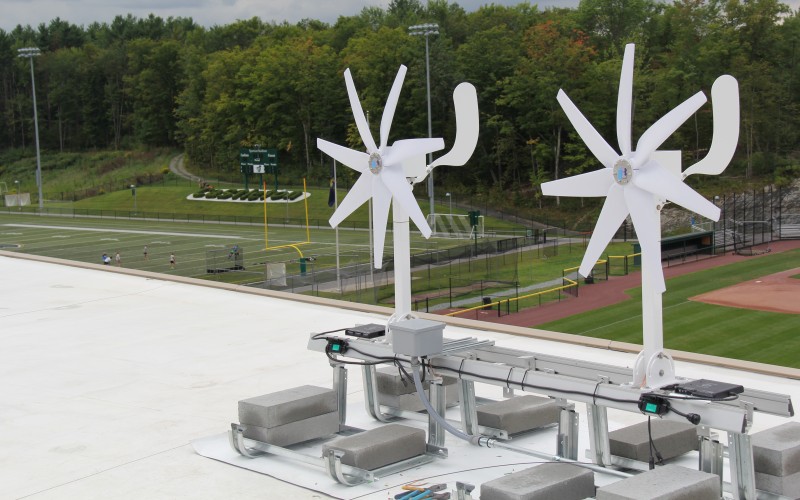Micro Wind Turbines
Micro Wind Turbines (MWTs) are small-scale wind energy devices that can be installed on buildings or in residential areas to generate clean, renewable electricity. These compact turbines offer a decentralized approach to wind energy production.

Micro-wind turbines on the roof (Castleton University)
job openings
View open jobs in this Solution
Example Companies
- Bergey Windpower - Manufactures small wind turbines for residential and commercial use.
- Windside - Produces vertical axis wind turbines for various applications.
- Hi-VAWT Technology - Develops innovative vertical axis wind turbines.
- Aeolos Wind Turbine - Offers a range of small wind turbines for different markets.
- ENESSERE - Designs and produces aesthetically pleasing small wind turbines.
Overview
Micro Wind Turbines (MWTs) are compact wind energy devices contributing significantly to sustainability efforts. Innovations like vertical axis turbines and small-scale options have emerged, utilized by leading entities in the renewable energy sector.
Learn More
Progress Made
Significant advancements have been made in micro wind turbine technology:
- Vertical Axis Turbines: Development of turbines that can operate in varied wind directions.
- Improved Efficiency: Enhanced blade designs and materials for better power generation.
- Smart Integration: Integration with smart home systems for optimized energy use.
Solutions by Sector
Residential
- Rooftop Turbines: Small turbines designed for installation on residential rooftops.
- Backyard Turbines: Standalone turbines for properties with sufficient space.
- Hybrid Systems: Combining micro wind turbines with solar panels for comprehensive renewable energy solutions.
Case Studies:
- Bergey Windpower, USA: Provides small wind turbines for residential use, with thousands of installations worldwide (Bergey Windpower).
- Hi-VAWT Technology, Taiwan: Develops innovative vertical axis wind turbines for urban environments (Hi-VAWT Technology).
- ENESSERE, Italy: Designs aesthetically pleasing small wind turbines for integration into architectural designs (ENESSERE).
Commercial and Industrial
- Building-Integrated Turbines: Wind turbines designed to be part of building structures.
- Parking Lot Turbines: Turbines installed in parking areas to generate power for facilities.
- Industrial Site Turbines: Larger micro turbines for industrial facilities with high energy demands.
Case Studies:
- Windside, Finland: Produces vertical axis wind turbines for various commercial applications, including telecommunications towers (Windside).
- Aeolos Wind Turbine, UK: Offers a range of small wind turbines for commercial and industrial use (Aeolos Wind Turbine).
- Urban Green Energy, USA: Develops hybrid wind and solar solutions for commercial properties (Urban Green Energy).
Agricultural
- Farm-Based Turbines: Micro wind turbines designed for agricultural applications.
- Water Pumping Systems: Wind-powered systems for irrigation and water distribution.
- Off-Grid Farm Solutions: Combining micro wind turbines with storage for off-grid farm operations.
Case Studies:
- Eocycle, Canada: Provides mid-size wind turbines suitable for farms and rural properties (Eocycle).
- Kliux Energies, Spain: Develops vertical axis wind turbines for agricultural applications (Kliux Energies).
- Xzeres Wind, USA: Offers small wind turbines for rural and agricultural settings (Xzeres Wind).
Lessons Learned
- Efficiency and Durability: MWTs must generate substantial power and withstand weather challenges.
- Strategic Placement: Optimal wind resource locations are essential for MWT effectiveness.
- Supportive Policies: Enabling policies with financial incentives and renewable energy mandates boost MWT adoption.
- Noise and Visual Impact: Addressing concerns about noise and aesthetics is crucial for community acceptance.
Challenges Ahead
- Cost: MWTs can be expensive compared to traditional turbines or other renewable energy sources.
- Size and Weight: MWTs' smaller size complicates installation and maintenance in some settings.
- Efficiency: Enhancing MWT efficiency is crucial for scalability and wider adoption.
- Grid Integration: Improving the integration of MWTs with existing power grids and energy storage systems.
Best Path Forward
- Continuous Research: Ongoing research is vital for enhanced MWT efficiency and cost-effectiveness.
- Public Awareness: Educating the public about MWT benefits and addressing misconceptions.
- Affordability: Further cost reduction through improved manufacturing and economies of scale.
- Incentives: Governments and utilities can offer incentives for MWT installation and use.
- Regulatory Support: Implementing supportive regulations and standards for MWT deployment.
- Integration with Smart Grids: Developing better ways to integrate MWTs with smart grid technologies.
Image credit: Castleton University